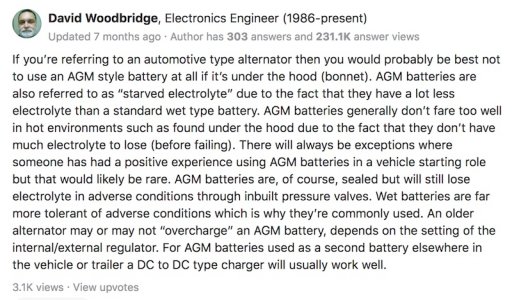.
Though I love my pair of Odyssey AGM in my trailer (charged only by solar through a solar charge controller), I won't put AGMs in as cranking battery(s), at least in my 2008 GMC diesel with an older 140amp alt.
View attachment 202679
..
Like anything else with vehicles, you'll find
all kinds of guys that will swear by using AGMs with regular alternators that say "I've been doing it for years with no problem and never had to charge them!" I'll bet their AGMs were not appropriately charged and did not last as long as they should have, and I bet they didn't even know they were shortening their battery's life.
Same with mixing batteries of different types, or even different ages or sizes of the same type, in a dual-battery set up with just an isolator between. With a proper
DC-DC charger, yes, because they do not "combine" the two batteries but keep them separate and send the charge from the cranking batt to the house batt when appropriate. I explain it more in post #7 here, in the
Super Simple Dual Battery Project, which also includes a link to a great Optima article on the subject.
Back to AGMs in
cranking positions: In my own research I've found wildly contradictory info; even on battery mfg pages. Some say AGMs do not get enough voltage from alternators to properly maintain a charge and that regularly being 15-20% under-charged will shorten their life. Others say they get too high a voltage from alternators so have a shortened life because of that. Some even show conflicting charts on what voltage AGMs should get and what alternators typically put out.
Some of the conflicting info is, no doubt, to the age of the article, the understanding--or lack of--the poster, and the fact that battery and alternator technology has advanced, rendering some older info obsolete. Though it still is all over the 'net, confusing folks and conflating facts.
Conflicting info, too, out there on how to accurately test an AGM. Here's one from Texford Battery Company that seems reasonable, and is pretty much what the Odyssey dealer around here does:
How Do I Test an AGM Deep Cycle?
Battery Chargers: If you're using a 110 battery charger to periodically maintain and top off your batteries, having a Smart Charger in which you can change the setting for various battery type profiles is important. Sounds like you are,
@FishinCrzy. Good smart chargers have microprocessors that know what type of battery they are connected to and adjust output accordingly. I've been using a
Potek Smart Charger and Maintainer for a few years and like it. It's not the most advanced or expensive, though has three levels of charging rate (2/10/20) and selectable battery type including AGM and GEL. Newer ones include lithium type. It's small enough I keep it in the van for travel now, and when around shore power hook it up occasionally to see what it says.
This is a good page on
Battery Charge Settings AGM vs Flooded vs GEL; content which is worth paying attention.
IF I was to put and keep an AGM under the hood, I'd be checking it more often and hooking it up more regularly to a smart charger.
I'm sure there will be a wild array of opinions and response to the OPs query and subsequent questions/posts, especially in a place like this with such a wide array of experience, though this is what I've learned so far.
I certainly don't pretend to be an expert, though did sleep in a Holiday Inn last night.

.










